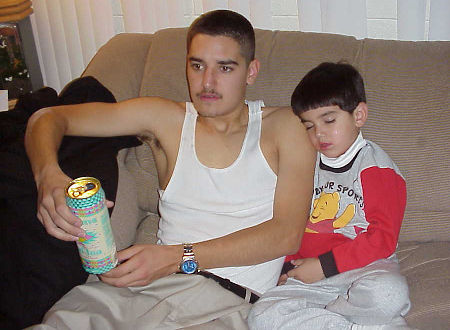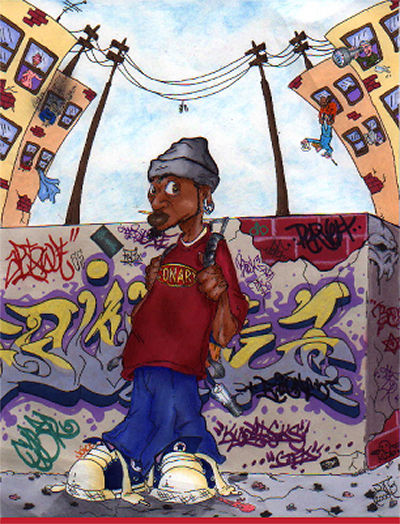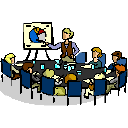
By Ansberto Vallejo

By Ansberto Vallejo
"Adolescence has been viewed by psychologists as a transitional period
between childhood and adulthood, a time when young people continue to develop
social and intellectual skills that will prepare them for adult roles and
responsibilities" (Harris, Duncan, Boisjoly 2002, p1). During this
period adolescents are influenced by their peers, role models and the media.
Often misleading adolescents to make incorrect choices that will affect
their entire life. Decision of illicit drug use can interfere with
the cognitive, emotional, and social development and is closely related
with delinquency" (Bruner and Fishman 1998 p.2). A study done in
Florida illustrated that at least 1 in 10 adolescents have used drugs in
the past 30 days. Drug use among adolescents is increasing and is a serious
problem which educators, family members, and legislators should address.
Although illicit drug use is staggering, few drug rehabilitation programs
are available, several of which are too expensive. However, school
guidance counselors can have a significant positive impact when working
with adolescents and drugs. This paper will focus on the importance
in working with students who are experiencing drug related situations.
 The focus
of the guidance counselor is to educate, promote discussion, increase awareness,
and implement responsible action. The targeted students were acquired by
using the Law of Parsimony in a previous presentation to the entire school.
After the presentation the students voluntarily signed up by way of email
in order to avoid embarrassment or shame. Also students were referred by
teachers based on drug use indications. During counseling, the guidance
counselor will act as a facilitator for small closed group counseling.
The small group will meet for four weeks, once a week for thirty minutes
after school with arrangement of transportation and parent permission.
The following sessions will take place in order:
The focus
of the guidance counselor is to educate, promote discussion, increase awareness,
and implement responsible action. The targeted students were acquired by
using the Law of Parsimony in a previous presentation to the entire school.
After the presentation the students voluntarily signed up by way of email
in order to avoid embarrassment or shame. Also students were referred by
teachers based on drug use indications. During counseling, the guidance
counselor will act as a facilitator for small closed group counseling.
The small group will meet for four weeks, once a week for thirty minutes
after school with arrangement of transportation and parent permission.
The following sessions will take place in order:

| Session I | Getting to Know You |
| Session II | Face the Experts |
| Session III | I've Got a Problem |
| Session IV | Discovering and Empowerment |
| * Before starting the sessions, the facilitator or group leader will establish rules, limitations, expectations and appropriate behavior. |
SESSION I
 Objective: To establish a mutual bond and respect for each other through social interaction. The idea is to explore participants hobbies, interests and perspectives. By having some knowledge of each other, participants will feel more comfortable when expressing themselves. Materials: Each participant will need a pencil and 8.5 X 11 sheet of paper containing statements that the counselor developed. Procedures:
|

| 1. Watches professional wrestlers on TV for more than 20 minutes |
| 2. Listens to country music |
| 3. Has been born in another country besides USA |
| 4. Has met a celebrity |
| 5. Plays football or basketball in the weekends |
| 6. Belongs to a school club or extra activities |
| 7. Owns a Walkman |
| 8. Goes to his/her friends house to play video games |
| 9. Part of his/her chore is to take out the trash |
| 10. Speaks another language other than English |
| 11. Has been to Ohio |
| 13. Is the oldest sibling |
| 14. Has seen a movie with Will Smith in it |
Processing Hints: Counselor may also participate; the objective
is also for the participants to get to know the counselor
The following statements can be including or can be changed according
to age, culture, and socioeconomic status. The counselor can make
up the statement to stimulate discussion.
| * Before starting Session II, the counselor will inform the participants the value and importance of expressing themselves and discussing the problems of drug usage. |
|
SESSION II FACE THE EXPERTS
|
| Purpose: To provide
an opportunity for students to examine issues related to the prevention
of drug abuse and promote patriotism.
Materials: None Procedures:
|
.gif)
| Why do you think the United States has the highest rate of drug abuse in the world? |
| Why is child abuse related to drug abuse? |
| Why does experimentation of drugs start so early an age? |
| Should we have anti smoking laws? If so, what kind? If not, why not? |
| Should children turn their parents into legal authorities if the parents use illegal drugs? |
| Should school authorities be able to search student lockers in search of illegal drugs? |
| Do warnings about alcohol and drug abuse really make a difference with teenagers? |
| Should students be allowed to drink if their parents let them? |
| Should drugs be legalized? |
| Should the government have permission to randomly test students for drug usage? |
Helpful Hints: In order to decide who wants to be President ask both students first. If both students want to be President have the group take a vote. The counselor does not have to be an expert on drugs to help participants. Also questions can be changed if necessary.
SESSION III
 Objectives: To examine personal problems related to school success, peer relationships, and a drug free society. Also, to identify what people might feel and do when they have problems and to brainstorm possible solutions to problems facing adolescents. Materials:Slips of paper and pencils Introduction: Everyone Has Problems 1. Begin by saying: "Everyone has problems. Some have problems which need more immediate attention than others. Some have problems which seem more serious than others. But, everyone struggles with problems from day to day." " How many of you have ever heard of Dear Abby?"... That's right, Abby writes a column which appears in many newspapers throughout the nation. People write her for advice. It is interesting to read about the kinds of problems that people are concerned about."  2.
Pass out identical slips of paper and then say: 2.
Pass out identical slips of paper and then say:
"Think of a problem that you have right now...or, think of a problem that you know a friend or classmate has at this time...or, if nothing comes to mind, then think of a problem that students your age have, one that might be interesting for us to discuss. In addition, I have other problems that students your age are experiencing and I will include those too." 3. "Without using names, write down a problem on the piece of paper. Don't sign your name. Hand them into me" 4. Collect the papers and mix them up. You can use the drug related ones or use the problems that were prepared ahead of time. 5. Read the first problem aloud and say: "First, If you had a problem like this, how would you be feeling?" Okay, if you felt that way, how might you behave or act?" 6. Form a circle with group and state that "we have tried to be understanding and what would a person do in the case of the first problem. (For example, One of my friends is starting to get weird-skipping school and getting high. He used to not be that way. 7. Perform a go around strategy using high facilitative responses using about four problems. Every student should have the opportunity to share their thoughts. Helpful Hints:
End by telling students that sometimes people are only seeking a good listener
and are not usually seeking advice. Tell them to avoid giving advice.
|
| 1. My parents don't trust me. They treat me like a little kid. |
| 2. My dad is a nice guy, except when he is drinking. He is funny for a while, then gets mean. What should I do? |
| 3. I know a girl who thinks that she is pregnant. She asked me what to do? What should I tell her? |
| 4. I don't like the way I look. I hate to see myself in a mirror. |
| 5. My older brother was caught smoking marijuana in school and now the administration thinks that I am like him. |
| 6. I like a girl but she doesn't like me. |
| 7. I don't have a close friend. There is nobody I can really talk to about things. |
| 8. I have been offered to sell drugs. It seems like good money and my family needs it. What should I do? |
 |
|
Purpose: To provide an atmosphere where students can discover their inner dialogue and express their concerns and ideas. By coloring, a listening environment is created and positive changes can occur. Materials: coloring pencils, or crayons and uncolored mandalas which can be downloaded from: http://www.coloringtherapy.com Procedures:
Helpful Hints: Remind students that you are not searching for artistic talent. Students should be able to enjoy this activity. Because mandalas require large amounts of work, students can work on them at their own time as a healing tool after the counselor does not meet with them anymore. Also the counselor can set a date when students can bring the mandalas and the counselor can display them in his office or in a showcase that schools usually have. Adolescents, like children enjoy displaying their work. CLOSURE Purpose: To provide a positive closure to counseling sessions and to increase each students self-esteem. 1. Form a circle with the group
and provide an empty chair.
|
| 1. My awareness of the need for alcohol and other drug prevention has increased. | SA | A | U | D | SD |
| 2. I am aware of how peer pressure is related to drug use | SA | A | U | D | SD |
| 3. I learned how to make better decisions. | SA | A | U | D | SD |
| 4. I am more confident in my ability to refuse drugs. | SA | A | U | D | SD |
| 5. My ability to give others feedback has improved. | SA | A | U | D | SD |
| 6. I can solve personal problems better. | SA | A | U | D | SD |
| 7. The sessions were interesting | SA | A | U | D | SD |
| 8. I enjoyed the class discussions | SA | A | U | D | SD |
| 9. I was able to express my thoughts through art | SA | A | U | D | SD |
| 10. I would recommend this program to others. | SA | A | U | D | SD |
|
Bruner, A. B., Fishman, M. (1998, August 19).
The
Journal of the American Medical Association. Vol. 280, n7.
Harris, K. M., Duncan,
G. J., Boisjoly, J. (2002, March). Evaluating the Role of “Nothing to Lose”
Attitudes on Risky Behavior in Adolescence. Social Forces. Vol.
80, i3.
Myrick, Robert D., Folk, Betsy E. (1991). The Prevention of Alcohol and Drug Abuse. p.166. Myrick, Robert D., Gonzalez, Gerardo M. (1990). Alcohol and Other Drug Prevention Through Teacher Advisors. p.71-76, p. 92 |